Good Diets for Teenage Guys
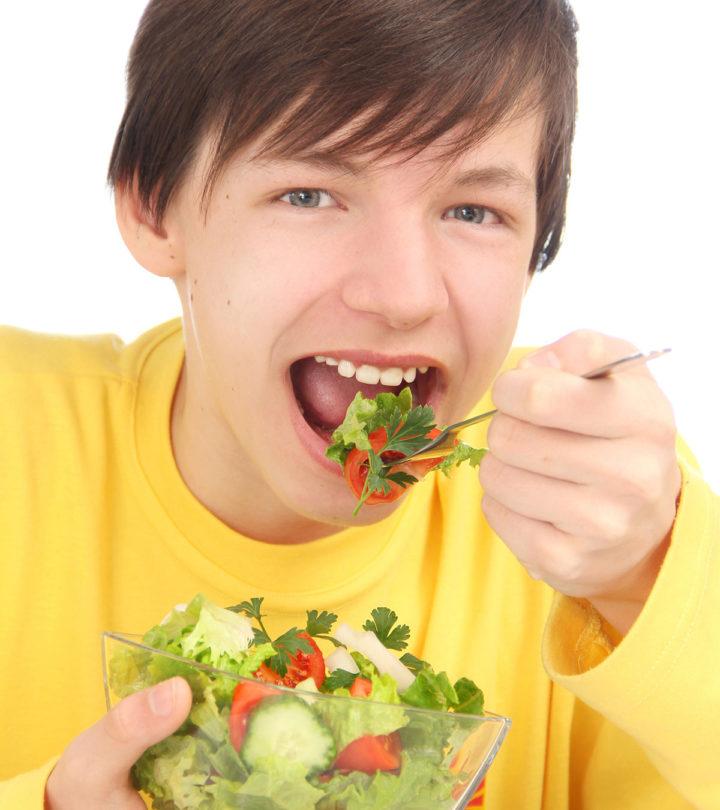
Image: Shutterstock
On average, teenage boys need around 2,800 calories every day, compared to an average of 2,200 calories that girls need (1). While both boys and girls need a wholesome, nutritious diet to support growth, the kind of foods that boys need could vary from what girls need.
In this MomJunction post, we tell you about the dietary requirements of teenage boys, the nutrients they need for healthy development, and a diet plan to promote healthy growth.
Nutrients A Teenage Boy Needs
All nutrients are vital for a child's growth, and they should have a balanced diet to achieve that. The primary nutrient groups are proteins, carbohydrates, fats, vitamins, and minerals. Proteins, carbs, and fats are the energy sources for the body, while vitamins and minerals are essential for the overall development of a teenage boy. Vitamins and minerals can be obtained from the same foods that also supply protein, carbohydrates, and fats.
1. Protein
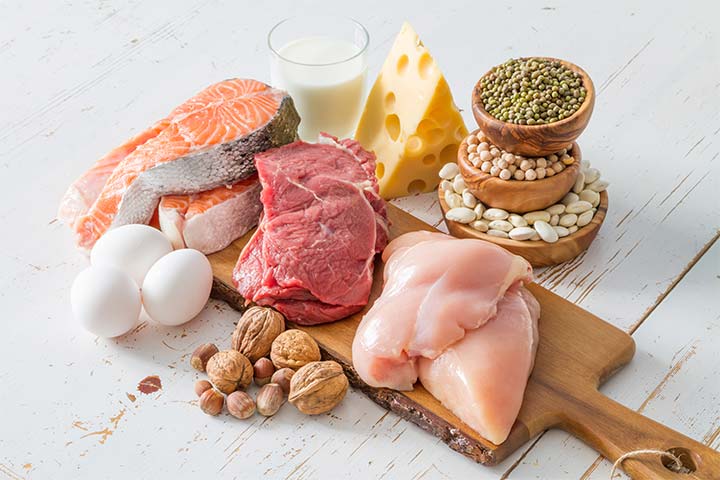
Image: iStock
- Protein is the building block of muscles, and 50% of body weight is made of protein (1).
- The most common sources of protein are meat, eggs, nuts, seeds, legumes, and dairy products.
- Focus on providing lean meat to your teenage boy since it contains adequate protein but low-fat content.
2. Carbohydrates

Image: iStock
- Carbohydrates are of two types: complex and simple (2) (3) (4). Complex carbohydrates burn slowly and provide sustained energy. Examples include wheat flour, rice, grains with fiber, and starchy vegetables like potatoes.
- Simple carbohydrates are sugars found in sweetened products such as cakes and beverages but are also found in healthier sources such as fruits, vegetables, and dairy.
- Carbohydrates provide the energy that teen boys need for their everyday activities. Complex carbohydrates should make 50 to 60% of a teenage boy's carbohydrate intake.
3. Fats
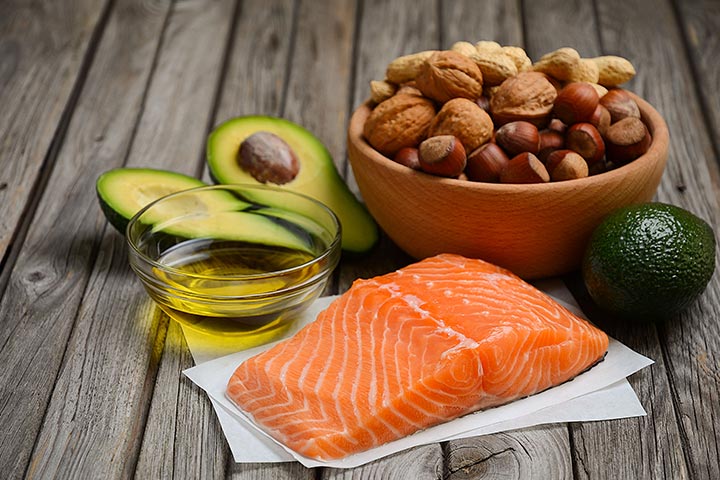
Image: iStock
- Fats could be monounsaturated, polyunsaturated fats, or saturated fats.
- Monounsaturated fats are the healthiest of all and are found in foods such as olive oil, peanut oil, peanut butter, and nuts like cashews, walnuts, and almonds.
- Polyunsaturated fats are found in oils from seeds of sunflower, safflower, cottonseed, and sesame seed.
- Saturated fat contains the most amount of cholesterol. It is found in dairy, red meat, coconut, and palm oil.
- Fats are essential for the body to absorb fat-soluble vitamins A, D, E, and K. Fat should not make for more than 30% of a teenage boy's diet; and saturated fat content should not be more than 10% of the total fat intake.
4. Vitamins:
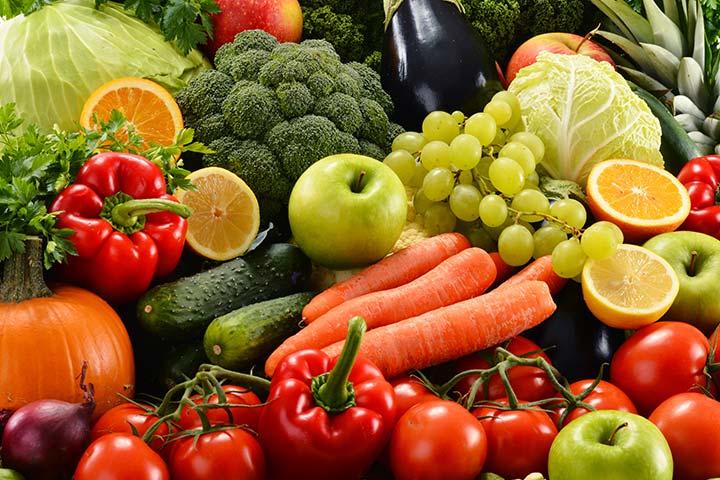
Image: iStock
- A teenage boy can get sufficient vitamins by consuming an assortment of fruits and vegetables.
- Teenagers usually tend to get lesser vitamin D than needed. Foods fortified with vitamin D (health drinks and cereal) and some exercise in the morning sun should prevent the likelihood of vitamin D deficiency.
5. Minerals:
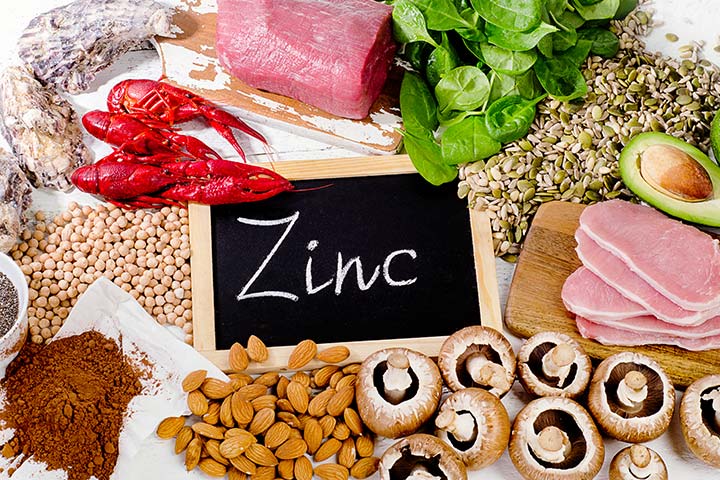
Image: iStock
- Minerals are micronutrients that are needed in minimal quantities.
- If your teenage boy has a healthy balanced diet, then obtaining the daily recommended amount of minerals from the food they eat will not be difficult. Essential minerals they should get through food include calcium, iron, zinc, magnesium, and iodine.
It is essential to provide the right amount of servings of different foods to ensure that your boy can get all the vital nutrients he needs.
What Is An Ideal Diet Plan For Teenage Boys?
Below is an ideal diet plan to meet the daily calorie requirements (2800 calories) of a teenage boy.
| Food Group | Number of servings a day |
|---|---|
| Whole grains and refined grains | 11 |
| Vegetables | 5 |
| Fruits | 4 |
| Dairy products | 3 |
| Meat, legumes, and nuts | 3* |
* The total of the servings should not exceed 7 ounces (200 grams)
Source: US Department of Health and Human Services (5)
It is good to know the size of each portion/serving before learning about the number of servings your teenage boy needs. Below is the quantity per serving of a food group:
| Food Group | Contents of One Serving |
|---|---|
| Whole grains and refined grains | 1 slice of bread or 1 cup of ready-to-eat cereal or 1/2 cup of cooked cereal, rice, or pasta |
| Vegetables | 1 cup of raw leafy vegetables or 1/2 cup of other vegetables cooked or raw or 3/4 cup of vegetable juice |
| Fruits | 1 medium apple, banana, orange, pear or 1/2 cup of chopped, cooked, or canned fruit or 3/4 cup of fruit juice |
| Dairy products | 1 cup of low-fat milk or yogurt or 1 1/2 ounces of low-fat natural cheese (such as Cheddar) or 2 ounces of low-fat processed cheese |
| Meat, legumes, and nuts | 2-3 ounces (57-85 grams) of cooked lean meat, poultry, or fish or 1 egg counts as 1 ounce (28 grams) of lean meat or 1/2 cup of tofu counts as 1 ounce (28 grams) of lean meat or 1/3 cup of nuts counts as 1 ounce (28 grams) of meat or 1/2 cup of cooked dry beans or 2 1/2-ounce soy burger or 2 tablespoons of peanut butter |
Source: US Department of Health and Human Services (5)
The above diet should allow a teenage boy to have requisite calories and nutrients for healthy growth. While parents strive to provide nourishment through meals, children often desire a tasty, between-the-meals snack, which could lead to extra calorie consumption.
Is It Okay For Teenagers To Have A Snack?
Yes. Children, especially teenagers, are quite likely to feel hungry between meals. There is nothing wrong with snacking as long as it is healthy like a fruit, a bowl of nuts, or any other homemade finger food. Processed foods with added sugar and saturated fats can be bad.
Some healthy snacks ideas for teenage boys could be (6) (7):
- Ready-to-eat fruits that require no peeling of skin or have skin that is easy to peel. A few examples are apples, pears, bananas, and grapes.
- Vegetables that can be enjoyed raw or boiled, with some seasoning. Examples include raw carrots, boiled celery, and broccoli seasoned with spices.
- If the teenager wants something exciting, then you can consider making a homemade vegetable omelet or cook a small bowl of vegetable spaghetti.
Even healthy meals could accumulate excess calories when not restricted. Eating nutritious food is healthy when you eat in the right quantities.
How Many Meals And Snacks Is Healthy In A Day?
Three meals and three snacks a day is an ideal combination to maintain a teenage boy's healthy body weight (8). Skipping breakfast is not ideal since it provides the required calories to jump-start the day. It may even minimize the risk of overeating or binge eating later in the day.
Teenage boys grow at a faster pace, which makes their dietary requirements a bit different compared to younger boys or adults. They could eat more of whatever you give them, or be fussy and picky about it. But you do not have to worry as long as they are eating healthily, and meeting their dietary requirements.
Do you follow a specific diet plan for your teenager? Tell us about it in the comments section below.
References:
MomJunction's articles are written after analyzing the research works of expert authors and institutions. Our references consist of resources established by authorities in their respective fields. You can learn more about the authenticity of the information we present in our editorial policy.
Recommended Articles:
- 10 Healthy Diet Tips And A Plan For Your Teenage Girl
- A Healthy Food Guide Pyramid For Kids And Teens
- 4 Essential Nutritional Requirements For Teenagers
- Top 10 Fitness Tips For Your Teenagers
The following two tabs change content below.
- Author

Swati Patwal is a clinical nutritionist and toddler mom with over eight years of experience in diverse fields of nutrition. She started her career as a CSR project coordinator for a healthy eating and active lifestyle project catering to school children. Then she worked as a nutrition faculty and clinical nutrition coach in different organizations. Her interest in scientific writing... more
Source: https://www.momjunction.com/articles/healthy-diet-tips-and-a-plan-for-your-teenage-boy_0079975/